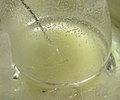an addition reaction is an organic reaction in which two or more molecules combine to form a larger molecule called the adduct. An addition reaction is...
3 KB (365 words) - 13:38, 16 July 2024
In organic chemistry, the Michael reaction or Michael 1,4 addition is a reaction between a Michael donor (an enolate or other nucleophile) and a Michael...
27 KB (2,837 words) - 10:58, 24 June 2025
A halogen addition reaction is a simple organic reaction where a halogen molecule is added to the carbon–carbon double bond of an alkene functional group...
7 KB (815 words) - 11:23, 24 June 2025
Markovnikov's rule (redirect from Markownikoff addition reaction)
of some addition reactions. The rule was formulated by Russian chemist Vladimir Markovnikov in 1870. The rule states that with the addition of a protic...
10 KB (1,130 words) - 11:11, 24 June 2025
In organic chemistry, an electrophilic addition (AE) reaction is an addition reaction where a chemical compound containing a double or triple bond has...
2 KB (243 words) - 11:21, 17 April 2024
In organic chemistry, a nucleophilic addition (AN) reaction is an addition reaction where a chemical compound with an electrophilic double or triple bond...
8 KB (910 words) - 13:13, 26 August 2024
stereoselectivity, high rate, and thermodynamic driving force. The reaction results in an anti-Markovnikov addition of a thiol compound to an alkene. Given the stereoselectivity...
25 KB (2,808 words) - 04:51, 22 June 2025
chemistry, an addition-elimination reaction is a two-step reaction process of an addition reaction followed by an elimination reaction. This gives an...
1 KB (109 words) - 21:09, 16 September 2022
conjugate addition is a type of organic reaction. Ordinary nucleophilic additions or 1,2-nucleophilic additions deal mostly with additions to carbonyl...
6 KB (631 words) - 10:56, 24 June 2025
The aldol reaction (aldol addition) is a reaction in organic chemistry that combines two carbonyl compounds (e.g. aldehydes or ketones) to form a new...
40 KB (4,255 words) - 19:40, 16 July 2025
chemical reaction is a process that leads to the chemical transformation of one set of chemical substances to another. When chemical reactions occur, the...
66 KB (8,048 words) - 01:14, 16 June 2025
Aldol condensation (redirect from Claisen–Schmidt reaction)
first (addition) stage of the process—the aldol reaction itself—as catalyzed by aldolases. However, the first step is formally an addition reaction rather...
18 KB (1,820 words) - 19:40, 16 July 2025
In organic chemistry, free-radical addition is an addition reaction which involves free radicals. These reactions can happen due to the free radicals having...
10 KB (938 words) - 10:33, 24 June 2025
anti addition are used to characterize the different reactions of organic chemistry by reflecting the stereochemistry of the products in a reaction. The...
8 KB (545 words) - 15:38, 9 August 2024
case is sensitive to temperature. The Kolbe–Schmitt reaction proceeds via the nucleophilic addition of a phenoxide, classically sodium phenoxide (NaOC6H5)...
4 KB (328 words) - 02:56, 16 May 2025
The Prins reaction is an organic reaction consisting of an electrophilic addition of an aldehyde or ketone to an alkene or alkyne followed by capture...
9 KB (1,067 words) - 01:02, 10 June 2025
1,3-Dipolar cycloaddition (redirect from 1,3-Dipolar addition)
the reaction between enamines and dimethyl diazomalonate (see scheme below). The polar reaction, N-cyclopentenyl pyrrolidine nucleophilic addition to the...
65 KB (6,458 words) - 13:19, 24 June 2025
Cycloaddition (redirect from Cyclo-addition reaction)
pericyclic. Nonconcerted cycloadditions are not pericyclic. As a class of addition reaction, cycloadditions permit carbon–carbon bond formation without the use...
12 KB (1,322 words) - 08:28, 6 July 2025
by "A more modern interpretation extends the scope of the reaction to include the addition of Grignard reagents to a wide variety of electrophilic substrates...
12 KB (1,132 words) - 13:06, 11 July 2025
Benzoin condensation (redirect from Benzoin addition)
In organic chemistry, the benzoin addition is an addition reaction involving two aldehydes (−CH=O). The reaction generally occurs between aromatic aldehydes...
7 KB (792 words) - 09:50, 22 November 2024
The Vilsmeier–Haack reaction (also called the Vilsmeier reaction) is the chemical reaction of a substituted formamide (1) with phosphorus oxychloride and...
5 KB (457 words) - 18:59, 26 September 2024
original reaction formed the alkylating agent using an alkene in the presence of a strong acid. The Ritter reaction proceeds by the electrophilic addition of...
9 KB (971 words) - 12:56, 24 June 2025
Thermodynamic reaction control or kinetic reaction control in a chemical reaction can decide the composition in a reaction product mixture when competing...
21 KB (2,751 words) - 18:12, 1 November 2024
Lewis acid catalysis (category Chemical reactions)
such as the Diels-Alder reaction and the ene reaction. In addition to accelerating the reactions, Lewis acid catalysts are able to impose regioselectivity...
45 KB (5,111 words) - 12:29, 27 June 2025
In organic chemistry, the oxymercuration reaction is an electrophilic addition reaction that transforms an alkene (R2C=CR2) into a neutral alcohol. In...
10 KB (1,160 words) - 11:42, 24 June 2025
The Stetter reaction is a reaction used in organic chemistry to form carbon-carbon bonds through a 1,4-addition reaction utilizing a nucleophilic catalyst...
19 KB (2,357 words) - 19:34, 9 March 2023
The Suzuki reaction or Suzuki coupling is an organic reaction that uses a palladium complex catalyst to cross-couple a boronic acid to an organohalide...
35 KB (3,984 words) - 17:56, 24 May 2025
This nucleophilic addition is a reversible reaction but with aliphatic carbonyl compounds equilibrium is in favor of the reaction products. The cyanide...
5 KB (410 words) - 12:15, 24 June 2025
Oxidative addition and reductive elimination are two important and related classes of reactions in organometallic chemistry. Oxidative addition is a process...
10 KB (1,213 words) - 12:50, 27 June 2025











